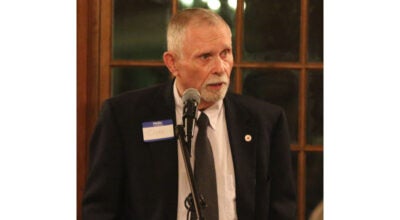COLUMN: Lafayette in the Virginia Campaign, Part I
Published 3:00 pm Wednesday, June 19, 2024

- Pictured is the Sleepy Hole Ferry historical marker at the intersection of Nansemond Parkway and Kings Highway. (Submitted photo)
|
Getting your Trinity Audio player ready...
|
Editor’s note: This is the sixth in a series of articles leading up to the bicentennial celebration. Previous articles are available at suffolkva250.com/history.
By Frank and Gloria Womble
Lafayette returned to France in January 1779 on a diplomatic mission to obtain more support for the war effort. Meeting with Benjamin Franklin and John Adams, the three men agreed to work together to promote a French attack on North America. By the spring, Lafayette became the key link between the United States and France. In his Memoires, he recorded, “I enjoyed the confidence of both countries and governments. I used the favor I had won at court and in French society to serve the American cause, to obtain every kind of help.” His efforts were successful and resulted in a pledge to send 6,000 troops, clothing, and 15,000 muskets to the American Army.
Lafayette returned to America in April 1780. French reinforcements arrived on July 11 under the command of General Rochambeau. On Feb. 20, 1781, Washington gave the official order to Lafayette to reassemble his light infantry division, coordinate with the French in the Chesapeake Bay, and attempt to capture the turncoat Benedict Arnold in Portsmouth, Virginia. His orders were explicit: “When you arrive at your destination,” Washington directed, “you must act as your own judgment and circumstances direct.” If Arnold “should fall into your hands, you will execute [him] in the most summary way.” Lafayette set out with 1,200 men the next day to Head of Elk, Maryland, the next day.
Arriving at Head of Elk on March 3, Lafayette used a flotilla of small boats to ferry his men down the Chesapeake Bay to Annapolis. He left the men there awaiting transport from a French frigate and headed further down the bay on a small armed barge with 30 officers and men. On March 14, they arrived in Yorktown, marking Lafayette’s first time in Tidewater, Virginia. Ironically, this was the same place where he would help besiege a British force seven months later, ending in their defeat.
Lafayette proceeded to Williamsburg, where he met with General Friedrich Wilhelm von Steuben, who commanded Washington’s troops in Virginia. Together, they devised a plan to oust the British from Virginia and capture Arnold. By March 20, Lafayette had crossed the James River and arrived in Suffolk at a camp near Sleepy Hole. Although the exact location is unknown, it was likely near the present-day Sleepy Hole Golf Course. There, he joined Brigadier General John Peter Gabriel Muhlenberg of Pennsylvania, with whom he had fought alongside at Brandywine and Monmouth. Lafayette borrowed a few of Muhlenberg’s militiamen and set out to explore the area. They ran into a small group of Hessian soldiers and exchanged fire with them in a brief skirmish, the first time in three years that Lafayette had been under fire.
In a letter to Virginia Governor Thomas Jefferson, Lafayette highlighted his difficulties: “…to My Great disappointment there was no Ammunition in Camp, and I have not yet Been able to learn when we are to get this indispensable Article.— the only thing I could do was to go down with such Riflemen and Militia as Had a few Cartridges — By this a trifling skirmish was Brought with the loss of one private killed, one officer and one private wounded on our side, and above twenty (four of whom taken) must Have Been lost for the enemy — But I could not Reconnoitre farther than the position to be taken at the time of operations, and the situation of the shipping, as want of Ammunition Rendered it imprudent to Engage.” Lafayette returned to Williamsburg, continuing to complain about a lack of supplies. For the time being, prudence demanded that Lafayette conduct only limited engagements while preserving his forces.
The American Friends of Lafayette is partnering with Suffolk 250 and the Constantia Chapter, Daughters of the American Revolution, to commemorate the bicentennial of Lafayette’s Farewell Tour with events in Suffolk in 2025: A memorabilia exhibit from Jan. 23 to March 1 at the Suffolk Center for the Cultural Arts; Lafayette’s arrival on Feb. 23 at the Suffolk Visitor Center/Riddick’s Folly; a banquet on February 25 at the Hilton Garden Inn Suffolk Riverfront; and a reception on Feb. 26 at the Washington Smith Ordinary in Historic Somerton
Frank and Gloria Womble are life members of the American Friends of Lafayette. Frank is a retired Army lieutenant colonel. Gloria is the America250 chair of Constantia Chapter, Daughters of the American Revolution, in Suffolk.





